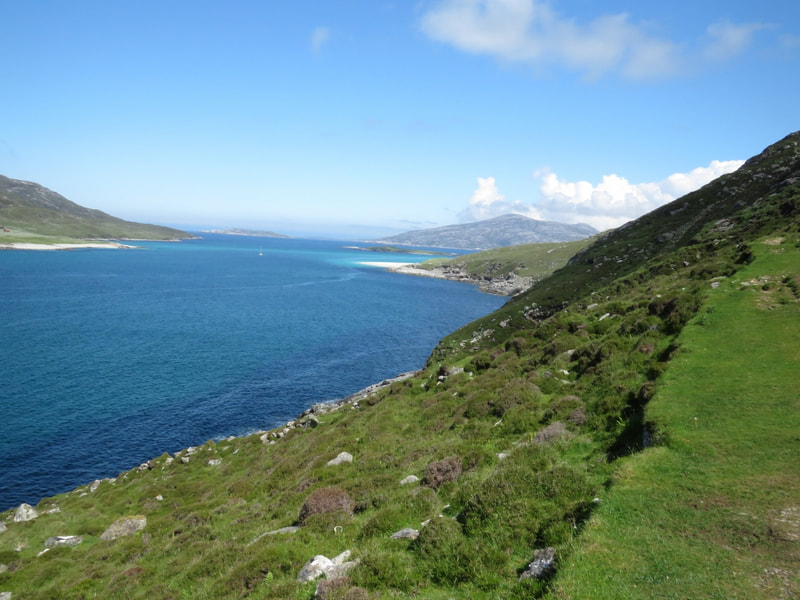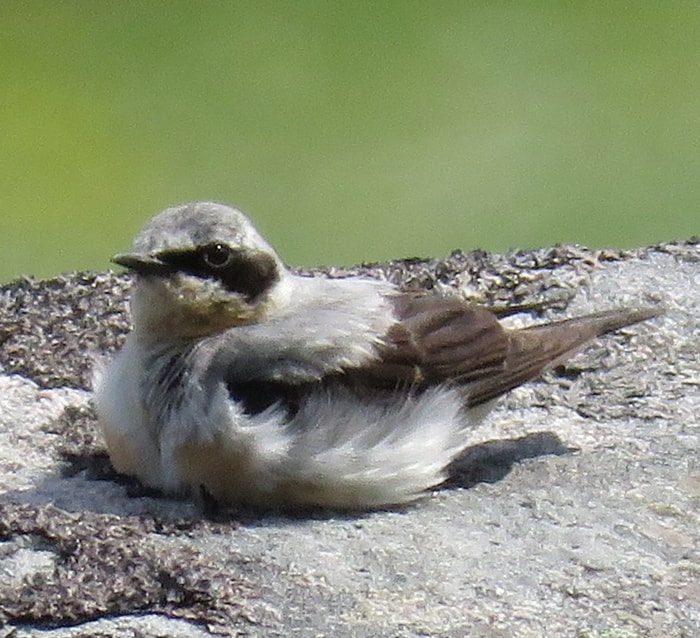 Huisinish
Huisinish Slow and narrow coastal road via Lord Dunmore’s castle at Ambhinnsuidhe. At Husinish we walk the fine beach and talk with an elderly woman who tends her enclosed vegetable plot, tells how she fertilises it with seaweed, and is still there at the end of our day when dunlin, turnstone and ring plover forage amongst fronds of seaweed. A rich coastal strand and a good trail through fields and on shore. The morning very wet, terrain rough. A geo where two black guillemot swim, their red legs visible. Fulmar nesting on the cliff.
A wild night at Tarbert and the boy racers screech about the place. They disperse, with the coming of the cuckoo at dawn.
6 July 2015. Huisinis via Tarbert along spectacular road, around coastal path with views to Scarp to deserted Crabhadail/ Glen Cravadale and views to N Lewis. Return around headland and beach
4.30 am kept awake by heavy rain on dormer velox window. A cold night. To Tarbert (an isthmus, a narrow strip of land) then west. We looked across the water to the sheer rocky flank of Beinn Dhubh and to Beinn Losgaintir beyond, with its cairn where we were yesterday.
Huisinish. We studied the tapestry panel of the Huisinish Road in the centre which is also cafe and shop. A long journey from Geocrab, South Harris. Through high lochans with bogbean, leaves only. The roller-coaster road, single track road built up over boggy ground, switch –back. It seems it will go on all morning. Mountains and sea spectacular. Twelve miles of single-track coastal road passing a Norwegian-built whaling station sets the scene for Huisinish on the west coast of Harris, looking out to the island of Scarp and the Atlantic Ocean. Weather colours the day. Wimbledon basked in the hottest July day ever. But this is Atlantic Coast and we’re prepared for Atlantic weather: cloud, wind and rain. Dreadful summer, the locals say. We don’t expect fine weather, but the effect of bright sun is breathtaking. The shell-sand beaches of Huisinis gleam cream and white and the sea shades from aquamarine through the subtlest blues and tints of pink that come from who knows where. It’s magic. We stop to marvel long before we reach our destination. Huisinish, Huisinis- Gaelic is fun, and bewildering. Letters cluster in unfamiliar pattern and variant spellings occur on maps and guides. English must have been as unpredictable before Dr Johnson pinned it down in his dictionary. We listen to the pronunciation of ‘machair’ and try it out. Machair those shell-sand ‘sea meadows’ dense with daisies and buttercups and with a richer flora of tall long headed-poppies and yellow violas.
Leaving the beach we head out across the machair where rabbits scurry for cover. The sandy bank is tunnelled with burrows that resemble a row of gun emplacements. Our track used to link Huisinis with the nearest settlement, a cliff-face path looking down upon a brilliant sea. We approach the deserted Crabhadail where lazy beds run down to the sea. Hardly lazy. Imagine the labour involved in building all those ridge and furrows to plant potatoes. Pressure of population meant that cultivation reached up the hillside. Now daisies in the furrows highlight the rows of lazy beds.
Cloud rolls in off the Atlantic, even though the sun shines brightly, and billows about a bowl of the North Harris hills. Beautiful luminous cloud. Sun glosses the sands on the beach, reflecting cloud, and pattern enthralls me.
July is the season for juveniles and this pipit looks wide-eyed and new to the world. With the fine breeding plumage of some adults soon to fade it's not the easiest season to identify birds. Families of stonechat were a delight.
Please respect copyright.
Images from July 2015













 RSS Feed
RSS Feed